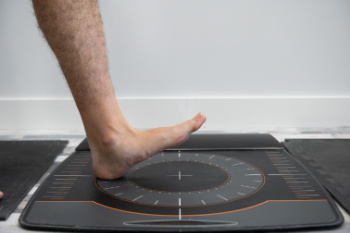Items filtered by date: August 2024
The Intricate Structure of the Foot

The foot’s structure is a marvel of anatomical design, consisting of 26 bones, numerous ligaments, and several joints that work harmoniously to support movement and balance. The major bones include the calcaneus, talus, and metatarsals, which form the framework of the foot. Ligaments, such as the plantar fascia and the deltoid ligament, provide stability and help maintain the arch. The ankle joint, where the tibia and fibula meet the talus, allows for flexibility and movement, which is essential for walking and running. Together, these components facilitate a range of movements while absorbing impact and distributing weight evenly. If you have injured your foot, it is suggested that you consult a podiatrist who can treat any foot condition, and can answer any questions you may have about the foot’s structure.
If you have any concerns about your feet, contact one of our podiatrists from Centers for Foot & Ankle Care. Our doctors can provide the care you need to keep you pain-free and on your feet.
Biomechanics in Podiatry
Podiatric biomechanics is a particular sector of specialty podiatry with licensed practitioners who are trained to diagnose and treat conditions affecting the foot, ankle and lower leg. Biomechanics deals with the forces that act against the body, causing an interference with the biological structures. It focuses on the movement of the ankle, the foot and the forces that interact with them.
A History of Biomechanics
- Biomechanics dates back to the BC era in Egypt where evidence of professional foot care has been recorded.
- In 1974, biomechanics gained a higher profile from the studies of Merton Root, who claimed that by changing or controlling the forces between the ankle and the foot, corrections or conditions could be implemented to gain strength and coordination in the area.
Modern technological improvements are based on past theories and therapeutic processes that provide a better understanding of podiatric concepts for biomechanics. Computers can provide accurate information about the forces and patterns of the feet and lower legs.
Understanding biomechanics of the feet can help improve and eliminate pain, stopping further stress to the foot.
If you have any questions please feel free to contact one of our offices located in Merrillville, Portage, Michigan City/LaPorte, and Schererville, IN . We offer the newest diagnostic and treatment technologies for all your foot and ankle needs.
Definition and Impact of a Stubbed Toe

A stubbed toe occurs when the toe forcefully contacts a hard surface, often causing sudden pain and discomfort. This common injury typically happens when the toe collides with furniture, a door frame, or any other solid object. The impact can lead to immediate swelling, bruising, and sometimes a visible injury such as a cut or scrape. While a stubbed toe is usually not severe, it can cause significant pain and difficulty walking. In some cases, the trauma might lead to a fracture or dislocation, which requires medical attention. To manage a stubbed toe, keeping the foot elevated assists in minimizing inflammation. Proper rest and avoiding pressure on the affected toe are essential for a swift recovery. If you have stubbed your toe and it is causing extreme or persistent pain, it is suggested that you promptly consult a podiatrist who can perform an accurate diagnosis to rule out a toe fracture.
Foot Pain
Foot pain can be extremely painful and debilitating. If you have a foot pain, consult with one of our podiatrists from Centers for Foot & Ankle Care. Our doctors will assess your condition and provide you with quality foot and ankle treatment.
Causes
Foot pain is a very broad condition that could be caused by one or more ailments. The most common include:
- Bunions
- Hammertoes
- Plantar Fasciitis
- Bone Spurs
- Corns
- Tarsal Tunnel Syndrome
- Ingrown Toenails
- Arthritis (such as Gout, Rheumatoid, and Osteoarthritis)
- Flat Feet
- Injury (from stress fractures, broken toe, foot, ankle, Achilles tendon ruptures, and sprains)
- And more
Diagnosis
To figure out the cause of foot pain, podiatrists utilize several different methods. This can range from simple visual inspections and sensation tests to X-rays and MRI scans. Prior medical history, family medical history, and any recent physical traumatic events will all be taken into consideration for a proper diagnosis.
Treatment
Treatment depends upon the cause of the foot pain. Whether it is resting, staying off the foot, or having surgery; podiatrists have a number of treatment options available for foot pain.
If you have any questions, please feel free to contact one of our offices located in Merrillville, Portage, Michigan City/LaPorte, and Schererville, IN . We offer the newest diagnostic and treatment technologies for all your foot care needs.
Ankle and Foot Fractures
 Ankle and foot fractures are common injuries in sports due to the high-impact nature of activities and sudden directional changes. These fractures occur when the bones in the foot or ankle break due to excessive force, such as during a fall, collision, or awkward landing. Symptoms of ankle and foot fractures include intense pain, swelling, bruising, and an inability to bear weight on the affected foot. The deformity may also be visible in severe cases. Athletes may hear a cracking sound at the time of injury. Treatment for these fractures typically involves immobilization, using a cast or splint to allow the bones to heal properly. Severe fractures may require surgery to realign and stabilize the bones with screws or plates. Targeted exercises are essential for restoring strength, flexibility, and function. Early diagnosis and appropriate treatment are imperative for a full recovery and to prevent long-term complications. If you have incurred a foot or ankle fracture in sports, it is suggested that you visit a podiatrist.
Ankle and foot fractures are common injuries in sports due to the high-impact nature of activities and sudden directional changes. These fractures occur when the bones in the foot or ankle break due to excessive force, such as during a fall, collision, or awkward landing. Symptoms of ankle and foot fractures include intense pain, swelling, bruising, and an inability to bear weight on the affected foot. The deformity may also be visible in severe cases. Athletes may hear a cracking sound at the time of injury. Treatment for these fractures typically involves immobilization, using a cast or splint to allow the bones to heal properly. Severe fractures may require surgery to realign and stabilize the bones with screws or plates. Targeted exercises are essential for restoring strength, flexibility, and function. Early diagnosis and appropriate treatment are imperative for a full recovery and to prevent long-term complications. If you have incurred a foot or ankle fracture in sports, it is suggested that you visit a podiatrist.
Sports related foot and ankle injuries require proper treatment before players can go back to their regular routines. For more information, contact one of our podiatrists of Centers for Foot & Ankle Care. Our doctors can provide the care you need to keep you pain-free and on your feet.
Sports Related Foot and Ankle Injuries
Foot and ankle injuries are a common occurrence when it comes to athletes of any sport. While many athletes dismiss the initial aches and pains, the truth is that ignoring potential foot and ankle injuries can lead to serious problems. As athletes continue to place pressure and strain the area further, a mild injury can turn into something as serious as a rupture and may lead to a permanent disability. There are many factors that contribute to sports related foot and ankle injuries, which include failure to warm up properly, not providing support or wearing bad footwear. Common injuries and conditions athletes face, including:
- Plantar Fasciitis
- Plantar Fasciosis
- Achilles Tendinitis
- Achilles Tendon Rupture
- Ankle Sprains
Sports related injuries are commonly treated using the RICE method. This includes rest, applying ice to the injured area, compression and elevating the ankle. More serious sprains and injuries may require surgery, which could include arthroscopic and reconstructive surgery. Rehabilitation and therapy may also be required in order to get any recovering athlete to become fully functional again. Any unusual aches and pains an athlete sustains must be evaluated by a licensed, reputable medical professional.
If you have any questions please feel free to contact one of our offices located in Merrillville, Portage, Michigan City/LaPorte, and Schererville, IN . We offer the newest diagnostic and treatment technologies for all your foot and ankle needs.
Are You Suffering From Ingrown Toenails?
The Diabetic Foot
 Diabetic foot is a term used to describe various complications that arise in the feet of individuals with diabetes. Due to prolonged high blood sugar levels, diabetic patients often experience nerve damage, neuropathy, and poor circulation. This can lead to a loss of sensation in the feet, making injuries and infections more likely and harder to detect and heal. Common issues include ulcers, infections, and, in severe cases, gangrene, which can necessitate amputation. To manage and prevent diabetic foot complications, daily foot care is crucial. Inspect your feet daily for cuts, blisters, redness, or swelling. Keep feet clean and moisturized, but avoid applying lotion between the toes to prevent fungal infections. Wear well-fitting shoes and avoid walking barefoot. If you have diabetes, it is strongly suggested that you make regular appointments with a podiatrist to monitor your foot health.
Diabetic foot is a term used to describe various complications that arise in the feet of individuals with diabetes. Due to prolonged high blood sugar levels, diabetic patients often experience nerve damage, neuropathy, and poor circulation. This can lead to a loss of sensation in the feet, making injuries and infections more likely and harder to detect and heal. Common issues include ulcers, infections, and, in severe cases, gangrene, which can necessitate amputation. To manage and prevent diabetic foot complications, daily foot care is crucial. Inspect your feet daily for cuts, blisters, redness, or swelling. Keep feet clean and moisturized, but avoid applying lotion between the toes to prevent fungal infections. Wear well-fitting shoes and avoid walking barefoot. If you have diabetes, it is strongly suggested that you make regular appointments with a podiatrist to monitor your foot health.
Diabetic foot care is important in preventing foot ailments such as ulcers. If you are suffering from diabetes or have any other concerns about your feet, contact one of our podiatrists from Centers for Foot & Ankle Care. Our doctors can provide the care you need to keep you pain-free and on your feet.
Diabetic Foot Care
Diabetes affects millions of people every year. The condition can damage blood vessels in many parts of the body, especially the feet. Because of this, taking care of your feet is essential if you have diabetes, and having a podiatrist help monitor your foot health is highly recommended.
The Importance of Caring for Your Feet
- Routinely inspect your feet for bruises or sores.
- Wear socks that fit your feet comfortably.
- Wear comfortable shoes that provide adequate support.
Patients with diabetes should have their doctor monitor their blood levels, as blood sugar levels play such a huge role in diabetic care. Monitoring these levels on a regular basis is highly advised.
It is always best to inform your healthcare professional of any concerns you may have regarding your feet, especially for diabetic patients. Early treatment and routine foot examinations are keys to maintaining proper health, especially because severe complications can arise if proper treatment is not applied.
If you have any questions please feel free to contact one of our offices located in Merrillville, Portage, Michigan City/LaPorte, and Schererville, IN . We offer the newest diagnostic and treatment technologies for all your foot and ankle needs.

